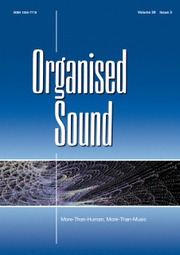Article contents
Navigating an Urban Archive: An exploration of wavefield synthesis as soundscape composition
Published online by Cambridge University Press: 18 June 2025
Abstract
This article examines the creation of an Urban Archive as an English Garden, a work that uses GPU-accelerated low-resolution wavefield synthesis (WFS) to combine field recordings, live performance and generative audio in real time. Owing to computational overhead, WFS is often pre-rendered, leading to a less dynamic and more static scope for the embodied and intersubjective nature of human sensory understanding, a tendency that can also be found in traditional soundscape composition. We argue that engagement with real-time WFS offers a new approach to soundscape composition, wherein musical-system design may have multiple agencies, or that of virtual environment, co-creator, archive and hybrid instrument. Through a post-phenomenological lens, an analysis of the work’s creation through different domains reveals how these technologies afford novel practices to engage with our sonic environments. Additionally, the article unpacks how this same process, grounded in site-responsive design offers new approaches to composition, performance and artistic collaboration across these practices.
Information
- Type
- Article
- Information
- Copyright
- © The Author(s), 2025. Published by Cambridge University Press
References
References
Videography
- 1
- Cited by


